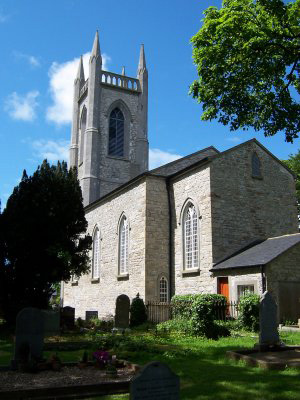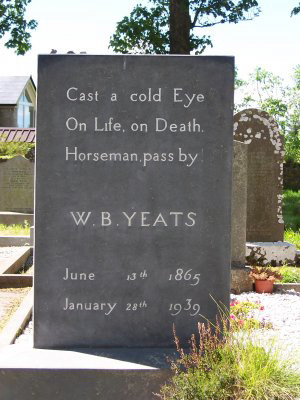 |
|

The church: St Columba's, Drumcliffe, County Sligo, Ireland.
Denomination: Church of Ireland.
The building: In 574 Columba founded a monastery at Drumcliffe, County Sligo. St Columba's church was built in 1809 using stones from the old monastery, and parts of a Celtic High Cross have apparently been found in the walls. A second 10th century High Cross which is carved with biblical scenes can be found by the entrance to the church from the main road. The only other remaining part of the original monastery is the round tower, which local legend says will fall down when the wisest man in the world passes under it. Suffice to say it was still standing after my visit. Inside, the church is fitted out in warm pine and the front wall is completely devoted to a large mural which reads, "Holy, Holy, Holy Lord God Almighty" and "Do this in Remembrance of Me". The walls are dotted with memorials to people who had warmed the pews long before my visit. A nice touch in this building which is steeped in history, is a noticeboard situated in a corner at the back of the church which is covered with samples of gaudily coloured children's artwork, praising God in its own, very modern, way.
The church: As is not unusual in Ireland, St Columba's is one of three churches that make up the Drumcliffe group of parishes, the other two being Lissadell Parish Church and St Kevin's Chapel of Ease, Munninane. The archdeacon has teaching responsibility for all three, which must make Sunday mornings busy for him. There is nothing unusual about the group of people who meet at St Columba's to worship, I would describe it as a typical family congregation. However, the church is renown because the Irish poet William Butler Yeats was buried here in 1948, having died in France in 1939 just before the Second World War. His grave, which bears an epitaph written by Yeats himself (see below) attracts hundreds if not thousands of visitors annually. Indeed, Yeat's great grandfather, John Yeats, was rector at Drumcliffe in the early 19th century.
Under bare Ben Bulben's head
In Drumcliffe churchyard Yeats is laid.
An ancestor was rector there
Long years ago, a church stands near,
By the road an ancient cross.
No marble, no conventional phrase;
On limestone quarried near the spot
By his command these words are cut:
Cast a cold eye
On life, on death.
Horseman, pass by!
The neighbourhood: Some of the most dramatic scenery in Ireland is found on the country's northwestern coast. Drumcliffe is in an area of exceptional scenic beauty and has religious associations stretching back to the very dawn of Christianity in Ireland. It is situated in a wide green valley, lying at the foot of Ben Bulben, reputedly climbed by St Columba himself to get near heaven with his prayers. Ben Bulben is a flat-topped limestone summit, which soars more than 520m above the coastal plain forming part of the Dartry Mountains. You can see it for miles as you drive around County Sligo. Below it is the beautiful Glencar Waterfall and Glencar Lake. This is Yeats country, and is easy to see why the landscape had such an influence on his writings.
The cast: Archdeacon Andrew Forster.
Service of Morning Prayer.
How full was the building?
I counted about 30 adults and 12 children, the building was approximately one third full.
Did anyone welcome you personally?
When it was established that I was staying for the service, and that I wasn't one of the many tourists who had just arrived on a coach tour, a friendly lady, who noted that I hadn't brought my prayer book with me, welcomed me. She then hurried off to get me a prayer book.
Was your pew comfortable?
Standard wooden pews with thin blue cushions, quite upright but with plenty of leg space.
How would you describe the pre-service atmosphere?
This was the most unusual pre-service atmosphere I have ever encountered. As I arrived at the church I noticed that there were three coaches parked up in the car park and each had spilled their contents into the church and its grounds. I walked past large groups in the graveyard who were informally queuing to take photographs of Yeats headstone. Inside the church it sounded like what I imagine Babel would have been like. People of all nationalities and tongues were looking around, taking photographs and lifting any information they could get their hands on. I heard German, English, American and Australian accents. I established myself inside the main church building, but every so often the doors would burst open, you would hear the click, see the flash and then the doors banged shut again! The congregation seemed totally unfazed by it all, and in between photographic sessions, the only sound was the children, who were all seated at the front of the church, chatting and laughing together. To be fair, once the service actually started, they somehow managed to stop the tourists and photographers from interrupting the proceedings.
What were the exact opening words of the service?
"Good morning, everyone. If you are visiting with us, you are especially welcome this morning and we hope you are blessed by your time with us."
What books did the congregation use during the service?
I collected a Church Hymnal on my way in, and we used the Common Book of Prayer. The New International Version of the Bible was placed in the pews.
What musical instruments were played?
A very ornately painted pipe organ.
Did anything distract you?
There was the most terrible buzzing noise coming from somewhere nearby my seat. Having wondered if it was associated with the organ, I eventually decided that it was a thermostatically controlled heater, which kept turning itself off and on throughout the service.
Was the worship stiff-upper-lip, happy clappy, or what?
The worship was very traditional, and at one point when we sang "Be Thou My Vision", so it was very traditional and very Irish!

Exactly how long was the sermon?
10 minutes.
On a scale of 1-10, how good was the preacher?
8 – As this man was on his third sermon of the morning, I would have excused him for sounding just a bit jaded. However, he spoke with such enthusiasm, you would have believed it was his first message of the day. I would describe his style as down to earth and genuine.
In a nutshell, what was the sermon about?
The sermon was based on a reading from Roman 3:10. Attention was drawn to the flowers in the church, and the point was made that beautiful as they were, they were cut flowers and cut flowers were dead flowers with no life of their own. Comparison was drawn to dead souls having no life and being cut off from God. For the flowers to live again would take a miracle. We also need a miracle, someone to raise our dead souls. God has a way to make us right with him. He has incredible love for us, and his desire for us is so strong he went from splendour in heaven to being a baby at Bethlehem. God's way to make us right with him is not about obeying laws, but having faith in Christ.
Which part of the service was like being in heaven?
Singing traditional Irish hymns in a traditional Irish church.
And which part was like being in... er... the other place?
Battling my way into the church through a sea of Americans wearing newly purchased Aran sweaters with their standard travelling uniform of checked trousers!
What happened when you hung around after the service looking lost?
The archdeacon was standing at the door as the congregation left and shook my hand firmly whilst making friendly conversation. As I headed towards the car park, another lady from the church started chatting, asking was I there on holiday. She also explained about the tea house and craft shop which is situated between the church and the car park, which used to be the church's visitor centre, but now is run more with the many visiting tourists in mind.
How would you describe the after-service coffee?
There was none. However, having been introduced to the tea house and craft shop, I thought it only right that I call in and do some sampling, so I had a pot of tea and a very large slice of Guinness cake for the princely sum of 4.05 Euros. I highly recommend the Guinness cake. Add to that an extensive range of gifts and books (including 26 different collections of WB Yeats poetry!) and you'll soon realise I didnít manage to get away with only spending the 4.05 Euros on nourishment!
How would you feel about making this church your regular (where 10 = ecstatic, 0 = terminal)?
7.
Did the service make you feel glad to be a Christian?
Yes.
What one thing will you remember about all this in seven days' time?
It's silly and childish, I know, but I'd love to see the German tourist's face when he gets his photographs developed and sees a Mystery Worshipper waving back at him in the corner of his picture!
| The Mystery Worshipper is sponsored by surefish.co.uk, the internet service provider from Christian Aid. By offering email services, special offers with companies such as amazon.co.uk and smile.co.uk, surefish raises more than £300,000 a year for Christian Aid's work around the world. Click here to find out how to become a Mystery Worshipper. And click here if you would like to reproduce this report in your church magazine or website. Top | Other Reports | Become a Mystery Worshipper! © Ship of Fools 2005 |